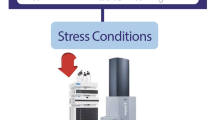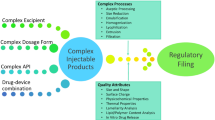Abstract
Purpose: Evaluate if crosslinked hard gelatin capsules (HGCs) havingdifferent in vitro dissolution profiles changed in vivo release times oraltered bioavailability of a drug marker; assess if a two-tier dissolutiontest (with and without enzyme) predicted in vivo performance.
Methods. Two classifications of stressed HGCs were artificiallyproduced by exposure to formaldehyde (HCHO). HGCs were categorizedas, a) pass/pass (p/p) which met in vitro dissolution criterion (75%drug dissolution at 45 min), b) moderately crosslinked fail/pass (f/p)which failed dissolution criterion in the absence of enzymes and passedin the presence of enzymes, and c) severely crosslinked fail/fail (f/f)which failed in vitro standards with or without enzymes. A six-way,single dose bioequivalence study (n = 10) administered the three HGCsunder the fasted and fed condition. In vivo capsule rupture and GItransit were monitored via gamma scintigraphy, and blood sampleswere collected through six hours.
Results. Each crosslinked HGC was bioequivalent to the control p/pcapsule when using AUC(0−∞) and Cmax for comparison. Meanin vivo disintegration of the p/p capsule was 7 ± 5 min for the fastedcondition and 11 ± 7 min for the fed condition. In vivo rupture forthe f/p capsule was 22 ± 12 min and 23 ± 11 min for the fasted andfed studies, respectively, while the f/f HGC ruptured at 31 ± 15 minand 71 ± 19 min under the fasted and fed condition, respectively.Onset of amoxicillin absorption was dependent on in vivo HGC ruptureand subsequent entry of the released radioactive marker into the smallintestine. Consequently, fasted Tmax values were significantly laterfor the f/p HGC (1.62 ± 0.53 hr) and f/f HGC (1.85 ± 0.58 hr) ascompared to the p/p HGC (1.17 ± 0.30 hr). Fed Tmax values werestatistically different only for the f/f capsule (2.55 ± 0.44 hr) whereTmax values for the p/p and f/p HGCs under the fed condition were1.50 ± 0.47 hr and 1.60 ± 0.46 hr, respectively.
Conclusions. A two-tier dissolution procedure that retested across-linked hard gelatin capsule with addition of gastric or intestinal enzymesprovided an adequate in vitro indicator of the formulation'sin vivo performance. The observed delays in the onset of amoxicillin absorptionand Tmax for the severely crosslinked f/f HGC was attributed todelayed in vivo capsule rupture, however, this delay did not adverselychange AUC(0−∞) nor Cmax.
Access this article
We’re sorry, something doesn't seem to be working properly.
Please try refreshing the page. If that doesn't work, please contact support so we can address the problem.
Similar content being viewed by others
REFERENCES
G. A. Digenis, T. B. Gold, and V. P. Shah. Cross-linking of gelatin capsules and its relevance to their in vitro· in vivo performance. J. Pharm. Sci. 83:915–921 (1994).
S. K. Taylor, F. Davidson, and D. W. Ovenall. Carbon-13 nuclear magnetic resonance studies on gelatin crosslinking by formaldehyde. Photogr. Sci. Eng. 22:134–138 (1978).
K. Albert, B. Peters, E. Bayer, U. Treiber, and M. Zwilling. Crosslinking of gelatin with formaldehyde: a 13C NMR study. Z. Naturforsch. 41:351–358 (1986).
K. Albert, E. Bayer, A. Worsching, and H. Vogele. Investigation of the hardening reaction of gelatin with 13C labeled formaldehyde by solution and solid state 13C NMR spectroscopy. Z. Naturforsch. 46:385–389 (1991).
T. B. Gold, S. L. Smith, and G. A. Digenis. Studies on the influence of pH and pancreatin on 13C-formaldehyde induced gelatin crosslinks using nuclear magnetic resonance. Pharm. Dev. Technol. 1:21–26 (1996).
H. Fraenkel-Conrat, M. Cooper, and H. S. Olcott. Reaction of formaldehyde with proteins. J. Am. Chem. Soc. 67:950–954 (1945).
P. Davis and B. E. Tabor. Kinetic study of the crosslinking of gelatin by formaldehyde and glyoxal. J. Polym. Sci. A1:799–815 (1963).
J. T. Carstensen and C. R. Rhodes. Pellicule formation in gelatin capsules. Pharm. Dev. Ind. Pharm. 19:1811–1814 (1993).
T. B. Gold, J. Buice RG, R. A. Lodder, and G. A. Digenis. Determination of extent of formaldehyde-induced cross-linking in hard gelatin capsules by near-infrared spectrophotometry. Pharm. Res. 14:1046–1050 (1997).
H. Mohamad, R. Renoux, S. Aiache, and J. M. Aiache. Study on the biopharmaceutical stability of medicines: application to tetracycline hydrochloride capsules I. In vitro study. S.T.P. Pharma. 2:531–535 (1986).
E. Doelker and A. C. Vial-Bernasconi. Interactions contenant-contenu au sein des capsules gelatineaues et evaluation critique de leurs effects sur la disponibilite des principes actifs. S.T.P. Pharma. 4:298–306 (1988).
M. Donbrow. Stability of the polyoxyethylene chain. Surfactant Sci. Ser. 23:1011–1072 (1987).
J. R. Schwier, G. G. Cooke, K. J. Hartauer, and L. Yu. Rayon: a source of furfural· a reactive aldehyde capable of insolubilizing gelatin capsules. Pharm. Technol. 17:78–79 (1993).
S. A. H. Khalil, L. M. M. Ali, and M. M. Abdel-Khalek. Effects of aging and relative humidity on drug release, Part I: Chloramphenicol capsules. Pharmazie 29:36–37 (1974).
H. W. Gouda, M. A. Moustafa, and H. I. Al-Shora. Effect of storage on nitrofurantoin solid dosage forms. Int. J. Pharm. 18:213–315 (1984).
P. York. The shelf-life of some antibiotic preparations stored under tropical conditions. Pharmazie 32:101–104 (1977).
H. Mohamad, R. Renoux, S. Aiache, J.-M. Aiache, and J.-P. Kantelip. Study on the biopharmaceutical stability of medicines: application of to tetracycline hydrochloride capsules II. In vivo study. S.T.P. Pharma. 2:630–635 (1986).
H. Mohamad, J.-M. Aiache, R. Renoux, P. Mougin, and J.-P. Kantelip. Study on the biopharmaceutical stability of medicines: application to tetracycline hydrochloride capsules IV. Complementary in vivo study. S.T.P. Pharma. 3:407–411 (1987).
H. Mohamad, J.-M. Aiache, R. Renoux, P. Mougin, J. Sirot, and J.-P. Kantelip. Study on the biopharmaceutical stability of medicines III: Application to ampicillin trihydrate capsules in vitro/in vivo study. S.T.P. Pharma. 2:912–917 (1986).
M. Dey, R. Enever, M. Kraml, D. G. Prue, D. Smith, and R. Weirstall. The dissolution and bioavailability of etodolac from capsules exposed to high-humidity conditions. Pharm. Res. 10:1295–1300 (1993).
D. Cade, N. Madit, and E. Cole. Development of a test procedure to consistently crosslink hard gelatin capsules with formaldehyde. Pharm. Res. 11:S147 (1994).
C. Noory, et al. Collaborative development of two-tier dissolution testing for gelatin capsules and gelatin-coated tablets using enzyme-containing media. Pharmacopeial Forum 24:7045–7050 (1998).
J. Sjövall, G. Alván, and D. Westerlund. Dose-dependent absorption of amoxycillin and bacampicillin. Clin. Pharm. Ther. 38: 241–250 (1985).
D. J. Schuirmann. A comparison of the two one-sided tests procedure and the power approach for assessing the equivalence of average bioavailability. J. Pharmacokin. Biopharm. 15:657–680 (1987).
G. A. Digenis, E. P. Sandefer, A. F. Parr, R. M. Beihn, C. McClain, B. M. Scheinthal, I. Ghebre-Sellassie, U. Iyer, R. U. Nesbitt, and E. Randinitis. Gastrointestinal behavior of orally administered radiolabeled erythromycin pellets in man as determined by gamma scintigraphy. J. Clin. Pharmacol. 30:621–631 (1990).
E. P. Sandefer, R. M. Beihn, A. F. Parr, B. M. Scheinthal, I. Ghebre-Sellassie, U. Iyer, R. U. Nesbitt, and G. A. Digenis. Erythromycin bioavailability and small intestine transit dependency: An evaluation by gamma scintigraphy. Pharm. Res. 6:S-155 (1989).
G. A. Digenis and E. P. Sandefer. Gamma scintigraphy and neutron activation techniques in the in vivo assessment of orally administered dosage forms. Crit. Rev. Ther. Drug Carrier Sys. 7:309–345 (1991).
K. M. Koch, A. F. Parr, J. J. Tomlinson, E. P. Sandefer, G. A. Digenis, K. H. Donn, and J. R. Powell. Effect of SAPP on ranitidine bioavailability and gastrointestinal transit time. Pharm. Res. 9:S-324 (1992).
K. M. Koch, A. F. Parr, J. J. Tomlinson, E. P. Sandefer, G. A. Digenis, K. H. Donn, and J. R. Powell. Effect of sodium acid pyrophosphate on ranitidine bioavailability and gastrointestinal transit time. Pharm. Res. 10:1027–1030 (1993).
G. L. Amidon, H. Lennernas, V. P. Shah, and J. R. Crison. A theoretical basis for a biopharmaceutic drug classification: the correlation of in vitro drug product dissolution and in vivo bioavailability. Pharm. Res. 12:413–420 (1995).
R. M. Mhatre, H. Malinowski, H. Nguyen, M. C. Meyer, A. B. Straughn, L. Lesko, and R. L. Williams. The effects of cross linking gelatin capsules on the bioequivalence of acetaminophen. Pharm. Res. 14:S-251 (1997).
J. Brown, N. Madit, E. T. Cole, I. R. Wilding, and D. Cade. The effect of cross-linking on the in vivo disintegration of hard gelatin capsules. Pharm. Res. 15:1026–1030 (1998).
Author information
Authors and Affiliations
Rights and permissions
About this article
Cite this article
Digenis, G.A., Sandefer, E.P., Page, R.C. et al. Bioequivalence Study of Stressed and Nonstressed Hard Gelatin Capsules Using Amoxicillin as a Drug Marker and Gamma Scintigraphy to Confirm Time and GI Location of In Vivo Capsule Rupture. Pharm Res 17, 572–582 (2000). https://doi.org/10.1023/A:1007568900147
Issue Date:
DOI: https://doi.org/10.1023/A:1007568900147




